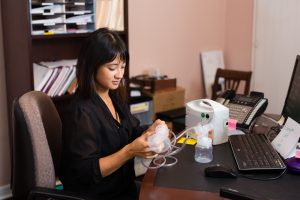Time, Space, and Workplace Lactation Policies
Policy
Providing time and space for milk expression (also known as pumping milk) is necessary to keep breastfeeding going if mothers and their babies must be separated. Having a policy helps ensure that all employees will have access to consistent support. A policy also helps clearly define the roles and responsibilities for both supervisors and employees. Ultimately, this helps bring about a worksite culture that normalizes lactation support as an accepted part of work-life balance.

Here is a sample policy that can be modified for any type of business:
Sample Workplace Lactation Policy
This handout can be used for establishing pumping guidelines at work between an employer and employee: Breastfeeding Accommodation Request Form
Can remote work be a breastfeeding accommodation?
Employees should not be required to work from home because they are breastfeeding or have requested lactation accommodations. However, employees who request remote work may be able to meet their lactation needs more efficiently and safely from home. Enabling remote work accommodations for lactation needs may also be required by anti-discrimination laws, particularly when remote work is being provided to other non-breastfeeding employees, like those with underlying health conditions. For more information on how to successfully manage telecommuting employees, see this Forbes article and resources from the Society of Human Resource Management.
Time
The best way to maintain lactation after returning to work is to schedule time to breastfeed the baby during the workday. However, if that is not possible, pumping breaks sustain lactation and help a female employee to reach her personal goals as a mother.
Missing even one pumping session can have negative side effects, including discomfort, leaking, infection, a drop in milk supply, and in the end, stopping breastfeeding.
How often should you pump?
If a woman works an 8-hour day, with no access to her baby during that time, she normally will need to take 2-3 breaks to pump milk. In a 12-hour shift, she will need 3-4 breaks. As the baby gets older and starts eating some solid foods, the number of times women need to pump will decrease.
How long will it take to pump milk each time?
When direct breastfeeding is not possible, a good double electric pump is a great way to remove milk from the breast. If using a double-sided electric pump, each pumping session will take about 15-30 minutes, plus time to get to and from the lactation space.
Where can you get a pump?
If you qualify for WIC and are returning to work, your local WIC office can give you a pump. To learn how to obtain a breast pump through your private insurance plan, call National Rehab Equipment, Inc. 1-800-451-6510. National Rehab Specialists are able to find out which breast pumps your plan will pay for, obtain the necessary paperwork, and bill your insurance carrier on your behalf.
Are pumping breaks paid?
Employee lactation breaks may be unpaid, with a few exceptions:
- If the employee is still working while pumping, they must be paid during that time. Note, an employee may choose to keep working, but may not be required to work while pumping. For example, a worker may choose to take a phone call or work on their computer while pumping but they must be paid for that time.
- If the employee chooses to express milk during a break that is already paid, they must still be paid for that time. For example, if your employees get a 30-minute paid lunch break, they may choose to pump during that time.If an employee needs 45 minutes to pump, eat, and get back to work, 30 minutes would be paid, and 15 minutes could be off the clock.
Space
COVID-19 Best Practice Checklist for Workplace Lactation Rooms
At minimum, a space designated for pumping milk should include these things:
- It should be at least 5 × 6 feet or larger – a storage closet can often be an adequate space!
- Room or space is clean
- Electrical Outlet (standard 110V)- If this is not possible, an extension cord could work or the mother can use a battery-operated pump
- Room locks from the inside. If this is not possible, the space should have a sign on the outside saying when someone is inside
- Comfortable chair
- Table or flat surface to hold the breast pump
- Room is located near a source of running water. If running water is not available, hand sanitizer and disinfectant wipes or spray can work
- Employee stores milk in a public area refrigerator or personal cooler.
Check out this video on space solutions for creating a Breastfeeding space in your workplace.
